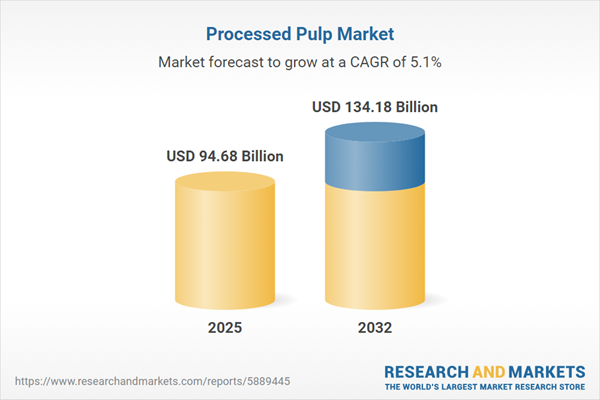Speak directly to the analyst to clarify any post sales queries you may have.
Senior leaders in the processed pulp market navigate ongoing transformation as they tackle shifts in technology, regulatory demands, and a new emphasis on sustainability. Success now demands precise insight into innovation, operations, and compliance, enabling organizations to balance risk and seize emerging market opportunities.
Market Snapshot: Processed Pulp Market Size and Growth Drivers
The processed pulp market is forecasted to grow from USD 89.97 billion in 2024 to USD 94.68 billion in 2025, ultimately reaching USD 134.18 billion by 2032. This represents a compound annual growth rate of 5.12%. This positive outlook is a direct result of increasing global sustainability mandates, modernization of supply chains, and accelerated adoption of advanced process technologies. Companies are prioritizing operational enhancements, adapting quickly to evolving standards, and placing greater importance on flexibility and performance to manage rising quality expectations. Leadership teams are concentrated on reinforcing their position in an environment where competitive pressures continue to intensify.
Scope & Segmentation: Strategic Focus in the Processed Pulp Market
This report provides a comprehensive analysis of the processed pulp market by breaking down critical segments that enable executive decision-makers to address both operational and strategic imperatives. Each segmentation area supports focused planning and improved resource allocation.
- Application: Packaging pulp responds to the surge in e-commerce and evolving logistics demands; specialty pulp drives product development in filtration, medical, and hygiene uses; tissue pulp remains a constant for commercial and consumer needs.
- Grade: Chemical pulps like kraft and sulfite serve multiple sectors; dissolving pulp plays a key role in high-value manufacturing; mechanical and semichemical grades address niche requirements.
- Fiber Type: Hardwood fibers produce soft and bright results suited for tissue and publishing; softwood fibers prioritize strength, particularly in industrial uses; blended fibers optimize for balance in performance and cost.
- Processing Method: Bleaching technologies such as ECF (Elemental Chlorine-Free) and TCF (Totally Chlorine-Free) bolster environmental credentials, while unbleached pulp meets demands for simplicity and natural finish.
- Regions: Distinctive supply chain, regulatory, and investment landscapes in the Americas, Europe, Middle East, Africa, and Asia-Pacific call for tailored growth and compliance strategies in each region.
- Key Companies: Leading players—including Oji Holdings Corporation, Stora Enso Oyj, Suzano S.A., UPM-Kymmene Corporation, and Asia-Pacific Resources International Limited—are paving the way with technical advances and building more agile supply networks to address region-specific challenges.
Key Takeaways: Strategic Insights for Senior Leaders
- Adopting advanced bleaching and water treatment technologies positions operations to align with sustainability requirements while maintaining process efficiency.
- Automation and real-time analytics offer a pathway to increased operational stability, reduced downtime, and more robust visibility throughout value chains.
- Accreditation through strict quality management and ongoing certification ensures readiness for compliance as safety and performance standards evolve, and creates access to untapped market segments.
- Diversified and expanded supplier relationships build resilience against fluctuations in regulations and operational disturbances, aiding in cost management efforts.
- Embracing recycling programs and alternative fiber sources strengthens supply chain adaptability and signals dedication to environmental stewardship.
- Targeted infrastructure investments in each region support compliance and unlock specific opportunities unique to local market conditions.
Tariff Impact: Implications for Sourcing and Margins
Recent U.S. tariff adjustments are driving enterprises in the processed pulp market to re-evaluate sourcing strategies and logistics operations. Companies are broadening their supplier networks, increasing focus on nearshoring, and improving inventory management practices. Exporters are also enhancing logistics capabilities and building new partnerships, reinforcing their ability to navigate risk and safeguard their operational margins as international trade terms shift.
Methodology & Data Sources
This report utilizes a blend of technical market analysis, ongoing regulatory monitoring, and sustainability benchmarking. Insights are derived from expert assessments and robust market modeling, ensuring senior decision-makers receive objective, actionable intelligence.
Processed Pulp Market: Why This Report Matters
- Enables senior executives to proactively address compliance, operational risk, and innovation challenges across the processed pulp sector.
- Equips leadership with deep market segmentation and intelligence to drive resilient, informed supply chain and investment decisions.
- Delivers strategic clarity, competitive insight, and a clear route to maintaining business advantage as the processed pulp market evolves.
Conclusion
Sustained leadership in the processed pulp market requires continuous improvement, localized investment, and agile supply strategy. The actionable intelligence delivered here supports organizations in strengthening operations amid ongoing industry transformation.
Additional Product Information:
- Purchase of this report includes 1 year online access with quarterly updates.
- This report can be updated on request. Please contact our Customer Experience team using the Ask a Question widget on our website.
Table of Contents
3. Executive Summary
4. Market Overview
7. Cumulative Impact of Artificial Intelligence 2025
Companies Mentioned
The companies profiled in this Processed Pulp market report include:- Oji Holdings Corporation
- Svenska Cellulosa Aktiebolaget SCA
- Suzano S.A.
- UPM-Kymmene Corporation
- Empresas CMPC S.A.
- Stora Enso Oyj
- Asia Pacific Resources International Limited
- Celulosa Arauco y Constitución S.A.
- Nippon Paper Group, Inc.
- Södra Cell AB
Table Information
| Report Attribute | Details |
|---|---|
| No. of Pages | 197 |
| Published | October 2025 |
| Forecast Period | 2025 - 2032 |
| Estimated Market Value ( USD | $ 94.68 Billion |
| Forecasted Market Value ( USD | $ 134.18 Billion |
| Compound Annual Growth Rate | 5.1% |
| Regions Covered | Global |
| No. of Companies Mentioned | 11 |









